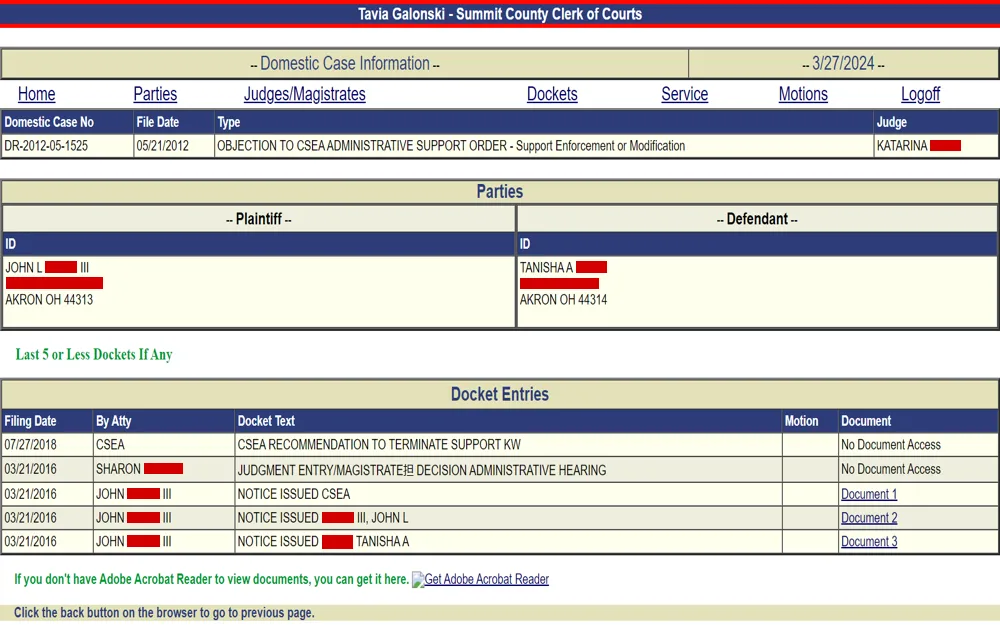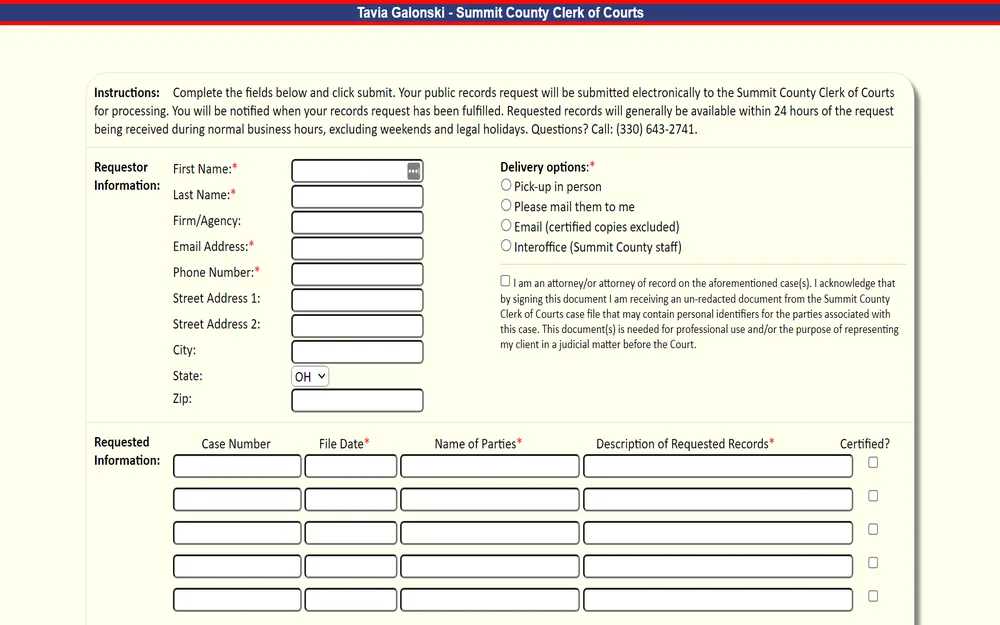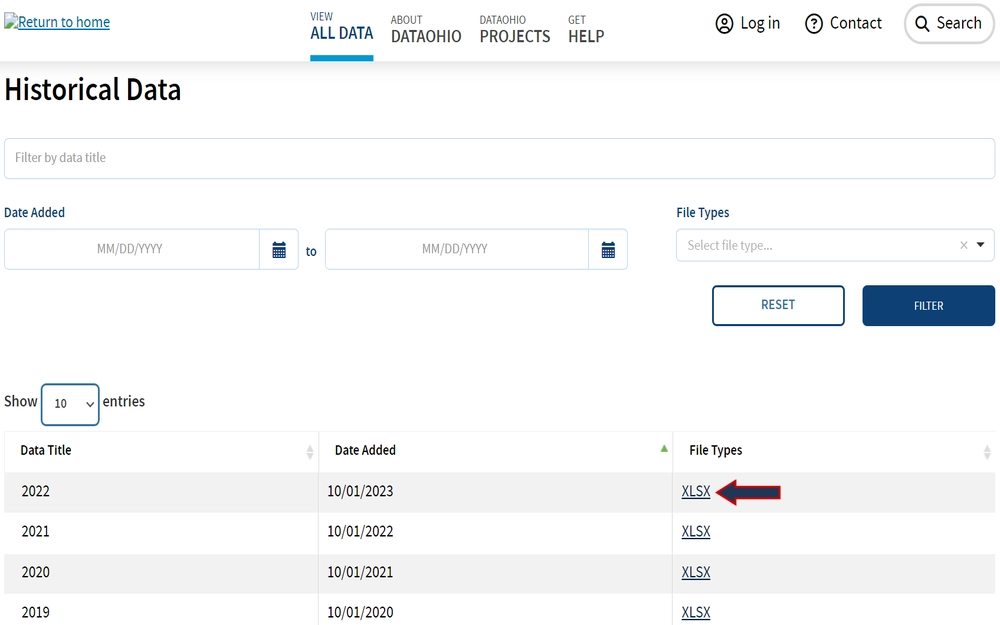Search free Summit County divorce records in no time using the links, tips, and guidance this article provides. Divorces are considered a matter of public record under the Ohio Open Records Act, but some details of the court documents may be redacted in public databases.
This resource offers useful links and record custodian contact details for individuals looking to seamlessly obtain information about divorces that took place in Summit County, Ohio.
How To Access Free Summit County Divorce Records
Divorce cases are heard in the Domestic Relations Court in Summit County. To access information about cases heard in this court, interested parties can contact the Summit County Clerk of Courts.
Court records for cases that were heard since 2002 are available online. The search tool is quite easy to use. To find divorce records, simply follow these steps:
- Navigate to the case search tool.1
- Select Domestic for the case type
- Select Search By Name
- Enter at least three characters of the person’s last name
- Enter their first name, if known
- Click Search
The search tool will bring up a list of any matching cases. Click on a case number to see information about the case, including the name and address of the involved parties, the case number, filing dates and the outcome of the case.

Cases that were heard prior to 2002 are not available via the online database. In addition, it’s not possible to request copies of court documents via this tool.
Those who require certified copies or who are looking for historic divorce records can make a public records request directly with the clerk of court by email, using the clerk of court’s online record request form, by mail or in person.3

The address for postal requests and in-person visits is:
Administration / Legal Division
205 S. High Street
Akron, OH 44308
Telephone: 330-643-2211
Fax: 330-643-2213
Email: [email protected]
The File Room is located in the basement.
There is a fee of $1 per page for certified copies and $5 per document for exemplification. This is in addition to the printing fee of $0.10 per page.
If a searcher makes a document request and asks to pick up the documents in person, the Clerk of Courts will hold the copies for 5 business days following the day of request. If the documents are not picked up within that time, the copies will be destroyed, and the searcher will have to make a new request.
The domestic relations court is the primary source of information for those looking for divorce records regardless of which city in the county the couple was living in. Divorces in the state have historically been tried at the county rather than the city level.
Domestic Relations courts were established in most Ohio counties in 1914. This means anyone looking for information about divorces that occurred within Summit County needs to contact the county clerk.
This applies to divorces in any Summit County city, including:
- Akron
- Green
- Munroe Falls
- Barberton
- Twinsburg
Prior to 1914, divorces were heard either at the probate courts or county courts of common pleas. Records for these cases are likely to be held with the county clerk.
Records from the mid-19th century may be found in state libraries; however, these are unlikely to be digitized, so it may take some time to search through them. For example, the Library of the Ohio History Connection holds divorce records for some of the state’s counties in its archives, but not all counties are covered. Those interested in divorces granted before 1843 may find some records on microfiche in these archives.
It can take some time to access divorce records via state or county agencies, especially if the name of the person being searched for is a common one. Narrowing the search down to a local level can be helpful – both because there are fewer records to look through, and because the smaller agencies are less likely to be busy and could potentially have the capacity to provide more personalized service.
To find out where a divorce might have taken place, search the U.S. Census to see where the couple was living around the time the divorce took place. This may help narrow down which counties to search.
How To Browse Divorce Records at the State Level via the Ohio Bureau of Vital Statistics
The Ohio Bureau of Vital Statistics maintains a downloadable list of public divorce records from 1990 to 2020.4 Outside of this time period, marriage and divorce records are not available online from the Bureau of Vital Statistics, and there’s no frequently-updated statewide divorce index.

Note: The downloadable list is quite extensive, so it’s best accessed on a desktop computer or laptop rather than via a mobile phone.
Those who require certified copies of marriage licenses. divorce decrees, and other vital records must contact the county in which the marriage or divorce took place. Members of the public can contact the Ohio Department of Health to request a search.5 In-person requests typically have a 1-hour turnaround time, while postal requests can take up to 6 weeks to be processed.
Requests for divorce records can be made by postal mail to the following address:
Ohio Department of Health
Vital Statistics
225 Neilston Street
Columbus, OH 43215
Tel: 614-466-2531
There’s a search fee of $21.50, which is non-refundable – even if no records are found. Rush requests and requests for certified copies might incur an additional fee. Searchers are asked to include payment via personal check or money order along with their records request.
Some third-party platforms offer access to divorce records from Ohio. However, these aren’t endorsed by the government, and their records may not be complete. On the other hand, free online archives may be a useful starting point, as they usually offer a user-friendly way to search.
Where possible, searchers are advised to try to determine where in the state the divorce took place and contact the Domestic Relations court or relevant county clerk directly for the most accurate and up-to-date information.
Are Divorce Records in Summit County Publicly Accessible?
Divorce records in Summit County are accessible to the public for responsible personal use under Section 149 of the Ohio Revised Code, but the information that’s available may be limited.6
For example, a member of the public can search for a divorce record to find out whether a dissolution of marriage took place and whether there were any children from the relationship. However, certain personal information may be redacted from the court documents.
To obtain full, certified copies of divorce papers or a copy of a divorce certificate, a searcher would have to provide proof of identity and have a verifiable reason for wanting to access the documents. In general, this would mean they are one of the parties involved in the case or a legal representative of one of those individuals.
In Ohio, there’s no such thing as common law divorce. Rather, common law spouses who wish to separate can do so informally or have the option of going through mediation or some other form of dispute resolution. Only a married couple can file divorce papers and have a formal divorce decree issued.
A decree is a document that provides a higher level of detail about the divorce, and therefore access to this kind of document is restricted to authorized individuals only in Ohio.
Because there’s no concept of common law divorce, it’s harder for those who are interested in researching their family tree to find information about unmarried couples who choose to separate. It’s also difficult to find records that predate 1954, as there is no statewide index for those cases.
Third-party providers may be able to assist people who are searching for recent and archived records, for example for the purposes of building a family tree. These services often index a wide array of databases, so they can show data county records custodians don’t have access to. However, if these providers aren’t endorsed by the state or local government, they can’t provide documents for use for official purposes.
With the help of the resources listed above, members of the public can search Summit County divorce records at no cost without having to identify themselves or give a reason for requesting the information.
References
1Summit County Clerk of Courts. (n.d.). Search For Cases. Retrieved March 27, 2024, from <https://clerkweb.summitoh.net/RecordsSearch/SelectDivision.asp>
2Summit County Clerk of Courts. (2024). Domestic – Search by Name. Retrieved March 27, 2024, from <https://clerkweb.summitoh.net/RecordsSearch/SearchByName.asp>
3Summit County Clerk of Courts. (n.d.). Public Records Request. Retrieved March 27, 2024, from <https://clerkweb.summitoh.net/prr/prr.aspx>
4Ohio Department of Health. (2020, July 7). Marriage & Divorce Reports. Retrieved March 27, 2024, from <https://data.ohio.gov/wps/portal/gov/data/view/marriage-and-divorce-reports>
5Ohio Department of Health. (n.d.). Contact Us. Retrieved March 27, 2024, from <https://odh.ohio.gov/help-center>
6Lawriter – Ohio Laws and Rules. (2024, January 10). Availability of public records for inspection and copying. Retrieved March 27, 2024, from <https://codes.ohio.gov/ohio-revised-code/section-149.43>
